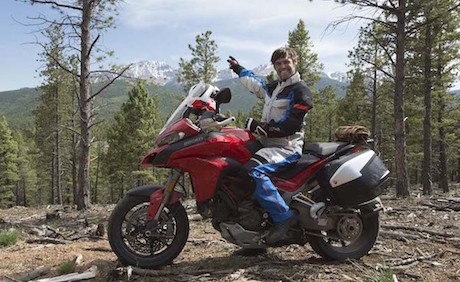The Pikes Peak International Hillclimb is one of the world’s most dangerous and exciting races on one of the most dangerous and exciting roads and Victory Motorcycles is tackling it head-on.
Just a couple of weeks after competing in the dangerous Isle of Man TT with an electric bike, Victory Motorcycles is tackling the famous hillclimb tomorrow (June 28, 2015) with a prototype V-twin called Project 156, proving their versatility and commitment to performance.
Project 156 was built in a partnership with Roland Sands Design of LA and will be raced up the mountain by US motorcycle journalist Don Canet.
Although no specifications have yet been released, it is believed to be “almost 1300cc”, with about 100kW of power.
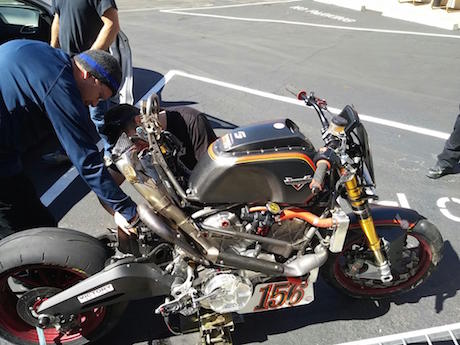
The bike crashed in practice less than two weeks ago, but has been straightened and fixed by the RSD crew, including young Cameron Brewer who gave up his spare time to work on the project. The bike was quickly back on the starting line and has qualified first for tomorrow’s race.

The event will be run under a cloud after the death this week in practice of local rider Cal Sorenson, making it two consecutive years riders have died on the spectacular Colorado mountain.
Yet in more than 92 years of competition, the dangerous circuit has only claimed five lives.
Today we rode the mountain on Victory bagger and cruiser motorcycles to get an appreciation of the dangers the competitors face.
The first part winds through tall pine forests and red-rock cuttings with gravel often cascading across the road. Hit some of that gravel and you may run off the road into a tree or a massive boulder.
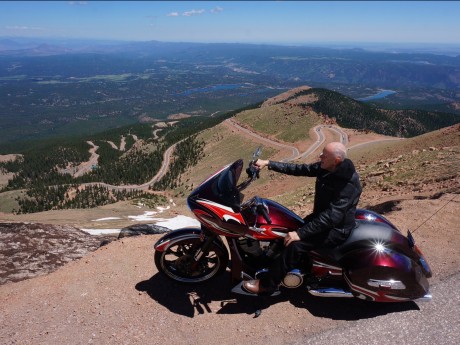
Above the tree line, the surrounding scenery tries to take your attention away from the road which snakes steeply up the mountain via tight hairpins, often with steep cambers and rises.
If you are afraid of heights, don’t bother. In most places there are no guard rails and above the tree line, there is nothing to stop you from a fall of several hundred metres.
The track is 20km (12.42 miles) and has 156 turns, hence the Project 156 name.
It climbs 4720ft (1440m) from the start line at Mile 7 on Pikes Peak Highway and finishes at 14,110ft (4300m). That’s almost double the height of Mt Kosciusko.
The temperature can vary substantially from top to bottom. It was near zero at the finish line, with wind chill as well and back at the starting line it’s in the mid 30s.
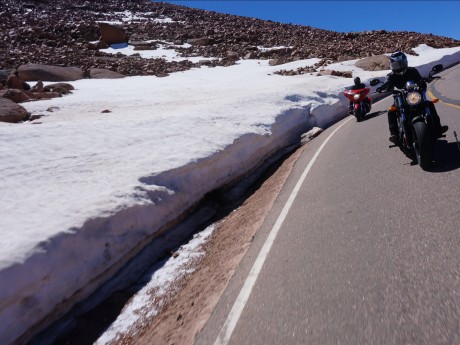
The scenery literally takes your breath away because of the lack of oxygen. I was gasping for breath, my legs felt like lead, my eyes were popping out of their sockets and after about half an hour I had a headache.
How difficult must it be for riders racing on the course? They would have to allow for the loss of energy and concentration from the lack of oxygen, plus the gradual lack of traction as the road surface gets colder as they near the finish line.
The road used to have a gravel section at the top, but it’s been paved since 2011 and it’s grippy and smooth.
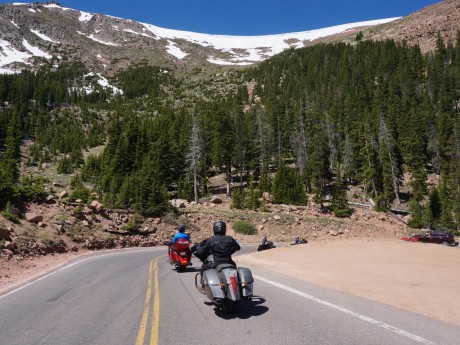
Pikes Peak Highway and the famous hillclimb have been on my bucket list for some time and even if you don’t go to the race event, the road is definitely worth riding.
The hillclimb began in 1916, making it the third oldest motorsport event in the Western Hemisphere behind the Indianapolis 500 and the Isle of Man TT.
Motorcycles haven’t aways competed. They were not included from 1977-79 and again from 1983-1990.
There are also classes for cars, trucks and quads and this year there are 145 entries which is a larger field than average.
One of the more interesting motorcycle entries this year is a stock Ducati Multistrada being ridden by Jamie Robinson, a former British racing champion. He rode it from Los Angeles across pavement and dirt roads to Pikes Peak and will ride it back again in an effort to prove the bike’s versatility.
Good luck to all who compete tomorrow.
